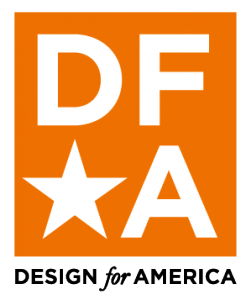
This past week we learned about the concept of design thinking. Design for America (DFA) at Illinois, is a student organization part of a national network of creators and innovators seeking to revolutionize the way college students engage with the world around us. DFA focuses on utilizing the design process to generate ingenious solutions to various challenges in our communities. Before this workshop, I have heard about the amazing work DFA through my involvement in Illinois Enactus. Design thinking is a powerful tool to that allows an individual to structure and channel their ideas to form a positive impact in the world.
Key Takeaways from DFA Workshop
From the DFA workshop, I learned how the design process is not a linear process. Although it can be separated into two stages, the design process over time is very iterative. It’s broken up into an understanding phase and then a create stage. I learned how imperative it is to first understand in order to design. I was surprised to learn how in-depth the understanding process is. DFA talked about how you need to go beyond just identifying a problem, you need to immerse yourself to truly understand all of a problems nuances.
What I really enjoyed about the DFA workshop was the hands on activity. It was a neat opportunity to collaborate with my peers to engage in design thinking. The problem we examined was blindness in the urban environment. We chose to design a problem for Jess, a legally blind college student who felt disconnected from many of her peers. First, we identified and made some assumptions about our user. Assumptions like “Jess knows how to navigate her surroundings as a legally blind individual” helped us begin the process of attempting to understand our user. From there, we made additional assumptions about how Jess hears, sees, and feels. I thought the most beneficial part of this process was when we started to create “How Can We” statements. This allowed us to narrow our focus from broad to specific. Ultimately, my group and I came up with the idea of a “smart cover” for blind walking sticks. Key features we incorporated into our idea was Bluetooth and GPS functionality, and rubber material so that it could be a one size fit all attachment.
When reflecting on the workshop led by DFA, I was reminded about Tim Brown’s, IDEO’s CEO, approach to design thinking. Brown discusses how close observation combined with brainstorming and rapid prototyping can streamline information shifts and produce more efficient an effective results. I noticed that the iterative process to come up with an end product idea required much collaboration and flexibility in thought. Furthermore, it was important to set time limits for each stage and to not get caught up in one part of the process for too long.
Other Design Thinking Resources
Other resources I examined this week associated with Design thinking was a podcast published by McKinsey titled The power of design thinking and a Ted Talk given by Joe Gebbia, the founder of Airbnb. In the McKinsey podcast, Hugo Sarrazin, a McKinsey director and the digital vice president of McKinsey Digital Labs talk about the impact of design and how it can drive positive change within an organization. Joe Gebbia’s Ted Talk explores how the design process can be tailored to address specific issues. Gebbia discusses how he founded Airbnb with the principle of trust in mind. This principle led him to tailor the design process to design for trust, resulting in the successful creation and expansion of Airbnb. The Ted Talk and McKinsey podcast are listed below. I am excited to continue using this framework as my team and I finalize our project idea.

Jason,
I loved how you referred the design firm IDEO. That’s all I was thinking about as the DFA kids presented on the design thinking methodology. I truly did feel like a IDEA designer when they asked to see needs, feel empathy for our clients, and create “how to” statements. This has definitely influenced the way I am thinking about our semester project for 3D printing. I want to try and isolate a feeling, an emotion, and create a solution that directly solves that need – instead of just another iPhone stand!
Thanks for this post!
Ajie
Hi Jason,
I really like your takeaway that the Design Process is not a linear process. This concept was also one of my greatest takeaways because I am used to processes being linear. However, through working with DFA, I realized that as creators/problem-solvers we need to be adaptable to unexpected challenges and maintain resiliency while going through the process. This is crucial for designers to understand because challenges will inevitably arise and there are important takeaways from later stages that could help resolve issues from earlier stages. Thus, being flexible while going through the Design Process will increase a designer’s chances at gaining more success than if they were to treat it as a linear process. Check out this article that I really like that talks about the benefits of a flexible mind: https://zenhabits.net/flex/
-Scott Provenzano
Hey Jason! I’ve seen the “How Airbnb designs for trust” video before (maybe in our IS/IT class? Not sure.), and I think about it differently now that I’ve learned about design thinking in a couple of my classes.
It’s cool to see how what we’ve learned in our IT classes as far as web design goes is connecting with the more tangible design lessons we learn in this class.